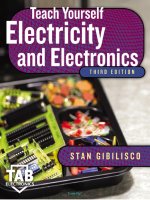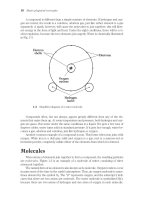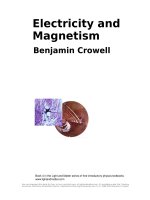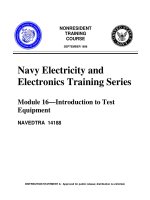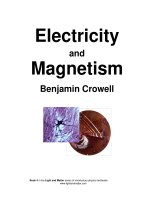- Trang chủ >>
- Khoa Học Tự Nhiên >>
- Vật lý
crowell. electricity and magnetism
Bạn đang xem bản rút gọn của tài liệu. Xem và tải ngay bản đầy đủ của tài liệu tại đây (2.43 MB, 164 trang )
Electricity
and
Magnetism
Benjamin Crowell
Book 4 in the Light and Matter series of introductory physics textbooks
www.lightandmatter.com
Electricity and
Magnetism
The Light and Matter series of
introductory physics textbooks:
1 Newtonian Physics
2 Conservation Laws
3 Vibrations and Waves
4 Electricity and Magnetism
5 Optics
6 The Modern Revolution in Physics
Electricity and
Magnetism
Benjamin Crowell
www.lightandmatter.com
Light and Matter
Fullerton, California
www.lightandmatter.com
© 1999-2002 by Benjamin Crowell
All rights reserved.
Edition 2.1
rev. 2002-10-30
ISBN 0-9704670-4-4
To Arnold Arons.
9Contents
Brief Contents
1 Electricity and the Atom 15
2 The Nucleus 41
3 Circuits, Part 1 71
4 Circuits, Part 2 95
5 Fields of Force 109
6 Electromagnetism 127
Exercises 147
Solutions 153
Glossary 155
Index 157
10
Contents
Contents
Preface 13
1 Electricity and
the Atom 15
1.1 The Quest for the Atomic Force 16
1.2 Charge, Electricity and Magnetism 18
1.3 Atoms 22
1.4 Quantization of Charge 28
1.5 The Electron 31
1.6 The Raisin Cookie Model of the Atom . 35
Summary 37
Homework Problems 38
2 The Nucleus 41
2.1 Radioactivity 41
2.2 The Planetary Model of the Atom 45
2.3 Atomic Number 48
2.4 The Structure of Nuclei 52
2.5 The Strong Nuclear Force, Alpha Decay
and Fission 56
2.6 The Weak Nuclear Force; Beta Decay 58
2.7 Fusion 61
2.8 Nuclear Energy and Binding Energies. 62
2.9 Biological Effects of Ionizing Radiation 65
2.10* The Creation of the Elements 67
Summary 69
Homework Problems 70
3 Circuits, Part 1 71
3.1 Current 72
3.2 Circuits 75
3.3 Voltage 76
3.4 Resistance 80
3.5 Current-Conducting Properties of Materi-
als 87
3.6∫ Applications of Calculus 90
Summary 91
Homework Problems 92
4 Circuits, Part 2 95
4.1 Schematics 96
4.2 Parallel Resistances and the Junction
Rule 97
4.3 Series Resistances 101
Summary 105
Homework Problems 106
11Contents
5 Fields of Force 109
5.1 Why Fields? 110
5.2 The Gravitational Field 112
5.3 The Electric Field 114
5.4∫ Voltage for Nonuniform Fields 120
5.5 Two or Three Dimensions 121
5.6∫ Field of a Continuous Charge
Distribution 123
Summary 119
Homework Problems 120
6 Electromagnetism .127
6.1 The Magnetic Field 128
6.2 Calculating Magnetic Fields
and Forces 126
6.3 Induction 132
6.4 Electromagnetic Waves 136
6.5 Calculating Energy in Fields 138
6.6* Symmetry and Handedness 142
Summary 143
Homework Problems 144
Exercises 149
Solutions 155
Glossary 157
Index 159
–
+
Note: See Simple Nature (www.lightandmatter.com/
area1sn.html) for coverage of the following topics:
the Biot-Savart law, LRC circuits, Maxwell's
equations.
12
Contents
13
Preface
Who are you? However much you relate your identity to your
physical appearance, you know that your personality ultimately
resides in the unique arrangement of your brain’s electrical network.
Mary Shelley may have conceived of electricity as a mystical life
force that could jerk the leg of a dead frog or animate Dr.
Frankenstein’s monster, but we now know the truth is both more
subtle and more wonderful. Electricity is not the stuff of life but of
consciousness.
Evidence is mounting that the universe has produced vast
numbers of suitable habitats for life — including, within our own
solar system, a watery ancient Mars and the oceans that lie under
the icy surface of Jupiter’s moon Europa. But even as we debate
claims of fossilized Martian bacteria, a third generation of radio
astronomers has found nothing but a wasteland of static in the
search for extraterrestrial intelligence.
Is life ubiquitous in the universe but consciousness rare? In
terms of geologic time, it took a mere wink of an eye for life to
come into being on Earth once conditions were suitable, so there is
every reason to believe that it exists elsewhere. Large-brained
mammals, however, appear as a virtual afterthought in the record of
our biosphere, which remains dominated by single-celled life. Now
you begin your study of electricity and magnetism, the phenomena
of which your own mind is made. Give some though to this image
of awesome loneliness: there may be no other planet in our galaxy
of ten billion stars where a collection of electric charges and fields
can ponder its own existence.
14
15
1 Electricity and the Atom
Where the telescope ends, the microscope begins. Which of the two
has the grander view?
Victor Hugo
His father died during his mother’s pregnancy. Rejected by her as a boy,
he was packed off to boarding school when she remarried. He himself never
married, but in middle age he formed an intense relationship with a much
younger man, a relationship that he terminated when he underwent a
psychotic break. Following his early scientific successes, he spent the rest of
his professional life mostly in frustration over his inability to unlock the
secrets of alchemy.
The man being described is Isaac Newton, but not the triumphant
Newton of the standard textbook hagiography. Why dwell on the sad side
of his life? To the modern science educator, Newton’s lifelong obsession
with alchemy may seem an embarrassment, a distraction from his main
achievement, which was the creation the modern science of mechanics. To
Newton, however, his alchemical researches were naturally related to his
investigations of force and motion. What was radical about Newton’s
analysis of motion was its universality: it succeeded in describing both the
heavens and the earth with the same equations, whereas previously it had
16
been assumed that the sun, moon, stars, and planets were fundamentally
different from earthly objects. But Newton realized that if science was to
describe all of nature in a unified way, it was not enough to unite the
human scale with the scale of the universe: he would not be satisfied until
he fit the microscopic universe into the picture as well.
It should not surprise us that Newton failed. Although he was a firm
believer in the existence of atoms, there was no more experimental evidence
for their existence than there had been when the ancient Greeks first posited
them on purely philosophical grounds. Alchemy labored under a tradition
of secrecy and mysticism. Newton had already almost single-handedly
transformed the fuzzyheaded field of “natural philosophy” into something
we would recognize as the modern science of physics, and it would be
unjust to criticize him for failing to change alchemy into modern chemistry
as well. The time was not ripe. The microscope was a new invention, and it
was cutting-edge science when Newton’s contemporary Hooke discovered
that living things were made out of cells.
1.1 The Quest for the Atomic Force
Newton was not the first of the age of reason. He was the last of the
magicians
John Maynard Keynes
Newton’s quest
Nevertheless it will be instructive to pick up Newton’s train of thought
and see where it leads us with the benefit of modern hindsight. In uniting
the human and cosmic scales of existence, he had reimagined both as stages
on which the actors were objects (trees and houses, planets and stars) that
interacted through attractions and repulsions. He was already convinced
that the objects inhabiting the microworld were atoms, so it remained only
to determine what kinds of forces they exerted on each other.
His next insight was no less brilliant for his inability to bring it to
fruition. He realized that the many human-scale forces — friction, sticky
forces, the normal forces that keep objects from occupying the same space,
and so on — must all simply be expressions of a more fundamental force
acting between atoms. Tape sticks to paper because the atoms in the tape
attract the atoms in the paper. My house doesn’t fall to the center of the
earth because its atoms repel the atoms of the dirt under it.
Here he got stuck. It was tempting to think that the atomic force was a
form of gravity, which he knew to be universal, fundamental, and math-
ematically simple. Gravity, however, is always attractive, so how could he
use it to explain the existence of both attractive and repulsive atomic forces?
The gravitational force between objects of ordinary size is also extremely
small, which is why we never notice cars and houses attracting us gravita-
tionally. It would be hard to understand how gravity could be responsible
for anything as vigorous as the beating of a heart or the explosion of
Chapter 1 Electricity and the Atom
17
(a)
(b)
(c)
gunpowder. Newton went on to write a million words of alchemical notes
filled with speculation about some other force, perhaps a “divine force” or
“vegetative force” that would for example be carried by the sperm to the
egg.
Luckily, we now know enough to investigate a different suspect as a
candidate for the atomic force: electricity. Electric forces are often observed
between objects that have been prepared by rubbing (or other surface
interactions), for instance when clothes rub against each other in the dryer.
A useful example is shown in figure (a): stick two pieces of tape on a
tabletop, and then put two more pieces on top of them. Lift each pair from
the table, and then separate them. The two top pieces will then repel each
other, (b), as will the two bottom pieces. A bottom piece will attract a top
piece, however, (c). Electrical forces like these are similar in certain ways to
gravity, the other force that we already know to be fundamental:
• Electrical forces are universal. Although some substances, such as fur,
rubber, and plastic, respond more strongly to electrical preparation
than others, all matter participates in electrical forces to some degree.
There is no such thing as a “nonelectric” substance. Matter is both
inherently gravitational and inherently electrical.
• Experiments show that the electrical force, like the gravitational force,
is an inverse square force. That is, the electrical force between two
spheres is proportional to 1/r
2
, where r is the center-to-center distance
between them.
Furthermore, electrical forces make more sense than gravity as candidates
for the fundamental force between atoms, because we have observed that
they can be either attractive or repulsive.
Section 1.1 The Quest for the Atomic Force
18
1.2 Charge, Electricity and Magnetism
Charge
“Charge” is the technical term used to indicate that an object has been
prepared so as to participate in electrical forces. This is to be distinguished
from the common usage, in which the term is used indiscriminately for
anything electrical. For example, although we speak colloquially of “charg-
ing” a battery, you may easily verify that a battery has no charge in the
technical sense, e.g. it does not exert any electrical force on a piece of tape
that has been prepared as described in the previous section.
Two types of charge
We can easily collect reams of data on electrical forces between different
substances that have been charged in different ways. We find for example
that cat fur prepared by rubbing against rabbit fur will attract glass that has
been rubbed on silk. How can we make any sense of all this information? A
vast simplification is achieved by noting that there are really only two types
of charge. Suppose we pick cat fur rubbed on rabbit fur as a representative
of type A, and glass rubbed on silk for type B. We will now find that there is
no “type C.” Any object electrified by any method is either A-like, attract-
ing things A attracts and repelling those it repels, or B-like, displaying the
same attractions and repulsions as B. The two types, A and B, always
display opposite interactions. If A displays an attraction with some charged
object, then B is guaranteed to undergo repulsion with it, and vice-versa.
The coulomb
Although there are only two types of charge, each type can come in
different amounts. The metric unit of charge is the coulomb (rhymes with
“drool on”), defined as follows:
One Coulomb (C) is defined as the amount of charge such that a force
of 9.0x10
9
N occurs between two pointlike objects with charges of 1 C
separated by a distance of 1 m.
The notation for an amount of charge is q. The numerical factor in the
definition is historical in origin, and is not worth memorizing. The defini-
tion is stated for pointlike, i.e. very small, objects, because otherwise
different parts of them would be at different distances from each other.
Chapter 1 Electricity and the Atom
19
A model of two types of charged particles
Experiments show that all the methods of rubbing or otherwise charg-
ing objects involve two objects, and both of them end up getting charged. If
one object acquires a certain amount of one type of charge, then the other
ends up with an equal amount of the other type. Various interpretations of
this are possible, but the simplest is that the basic building blocks of matter
come in two flavors, one with each type of charge. Rubbing objects together
results in the transfer of some of these particles from one object to the other.
In this model, an object that has not been electrically prepared may actually
possesses a great deal of both types of charge, but the amounts are equal and
they are distributed in the same way throughout it. Since type A repels
anything that type B attracts, and vice versa, the object will make a total
force of zero on any other object. The rest of this chapter fleshes out this
model and discusses how these mysterious particles can be understood as
being internal parts of atoms.
Use of positive and negative signs for charge
Because the two types of charge tend to cancel out each other’s forces, it
makes sense to label them using positive and negative signs, and to discuss
the total charge of an object. It is entirely arbitrary which type of charge to
call negative and which to call positive. Benjamin Franklin decided to
describe the one we’ve been calling “A” as negative, but it really doesn’t
matter as long as everyone is consistent with everyone else. An object with a
total charge of zero (equal amounts of both types) is referred to as electri-
cally neutral.
Self-Check
Criticize the following statement: “There are two types of charge, attractive and
repulsive.”
Coulomb’s law
A large body of experimental observations can be summarized as
follows:
Coulomb’s law
The magnitude of the force acting between pointlike charged objects at
a center-to-center distance r is given by the equation
F
=
k
q
1
q
2
r
2
,
where the constant k equals 9.0x10
9
N
.
m
2
/C
2
. The force is attractive if
the charges are of different signs, and repulsive if they have the same
sign.
Clever modern techniques have allowed the 1/r
2
form of Coulomb’s law to
be tested to incredible accuracy, showing that the exponent is in the range
from 1.9999999999999998 to 2.0000000000000002.
Note that Coulomb’s law is closely analogous to Newton’s law of gravity,
where the magnitude of the force is
Gm
1
m
2
/ r
2
, except that there is only
one type of mass, not two, and gravitational forces are never repulsive.
Because of this close analogy between the two types of forces, we can recycle
Either type can be involved in either an attraction or a repulsion. A positive charge could be involved in either an
attraction (with a negative charge) or a repulsion (with another positive), and a negative could participate in either
an attraction (with a positive) or a repulsion (with a negative).
Section 1.2 Charge, Electricity and Magnetism
20
a great deal of our knowledge of gravitational forces. For instance, there is
an electrical equivalent of the shell theorem: the electrical forces exerted
externally by a uniformly charged spherical shell are the same as if all the
charge was concentrated at its center, and the forces exerted internally are
zero.
Conservation of charge
An even more fundamental reason for using positive and negative
signs for electrical charge is that experiments show that charge is con-
served according to this definition: in any closed system, the total amount
of charge is a constant. This is why we observe that rubbing initially
uncharged substances together always has the result that one gains a
certain amount of one type of charge, while the other acquires an equal
amount of the other type. Conservation of charge seems natural in our
model in which matter is made of positive and negative particles. If the
charge on each particle is a fixed property of that type of particle, and if
the particles themselves can be neither created nor destroyed, then conser-
vation of charge is inevitable.
Electrical forces involving neutral objects
As shown in figure (a), an electrically charged object can attract
objects that are uncharged. How is this possible? The key is that even
though each piece of paper has a total charge of zero, it has at least some
charged particles in it that have some freedom to move. Suppose that the
tape is positively charged, (b). Mobile particles in the paper will respond
to the tape’s forces, causing one end of the paper to become negatively
charged and the other to become positive. The attraction is between the
paper and the tape is now stronger than the repulsion, because the
negatively charged end is closer to the tape.
Self-Check
What would have happened if the tape was negatively charged?
The path ahead
We have begun to encounter complex electrical behavior that we
would never have realized was occurring just from the evidence of our
eyes. Unlike the pulleys, blocks, and inclined planes of mechanics, the
actors on the stage of electricity and magnetism are invisible phenomena
alien to our everyday experience. For this reason, the flavor of the second
half of your physics education is dramatically different, focusing much
more on experiments and techniques. Even though you will never actually
see charge moving through a wire, you can learn to use an ammeter to
measure the flow.
Students also tend to get the impression from their first semester of
physics that it is a dead science. Not so! We are about to pick up the
historical trail that leads directly to the cutting-edge physics research you
read about in the newspaper. The atom-smashing experiments that began
around 1900, which we will be studying in chapters 1 and 2, were not
that different from the ones of the year 2000 — just smaller, simpler, and
much cheaper.
(a) A charged piece of tape attracts
uncharged pieces of paper from a dis-
tance, and they leap up to it.
+
+
+
+
+
–
–
(b) The paper has zero total charge,
but it does have charged particles in
it that can move.
It wouldn’t make any difference. The roles of the positive and negative charges in the paper would be reversed, but
there would still be a net attraction.
Chapter 1 Electricity and the Atom
21
Magnetic forces
A detailed mathematical treatment of magnetism won’t come until
much later in this book, but we need to develop a few simple ideas about
magnetism now because magnetic forces are used in the experiments and
techniques we come to next. Everyday magnets come in two general types.
Permanent magnets, such as the ones on your refrigerator, are made of iron
or substances like steel that contain iron atoms. (Certain other substances
also work, but iron is the cheapest and most common.) The other type of
magnet, an example of which is the ones that make your stereo speakers
vibrate, consist of coils of wire through which electric charge flows. Both
types of magnets are able to attract iron that has not been magnetically
prepared, for instance the door of the refrigerator.
A single insight makes these apparently complex phenomena much
simpler to understand: magnetic forces are interactions between moving
charges, occurring in addition to the electric forces. Suppose a permanent
magnet is brought near a magnet of the coiled-wire type. The coiled wire
has moving charges in it because we force charge to flow. The permanent
magnet also has moving charges in it, but in this case the charges that
naturally swirl around inside the iron. (What makes a magnetized piece of
iron different from a block of wood is that the motion of the charge in the
wood is random rather than organized.) The moving charges in the coiled-
wire magnet exert a force on the moving charges in the permanent magnet,
and vice-versa.
The mathematics of magnetism is significantly more complex than the
Coulomb force law for electricity, which is why we will wait until chapter 6
before delving deeply into it. Two simple facts will suffice for now:
(1) If a charged particle is moving in a region of space near where other
charged particles are also moving, their magnetic force on it is directly
proportional to its velocity.
(2) The magnetic force on a moving charged particle is always perpen-
dicular to the direction the particle is moving.
Example: A magnetic compass
The Earth is molten inside, and like a pot of boiling water, it roils
and churns. To make a drastic oversimplification, electric charge
can get carried along with the churning motion, so the Earth
contains moving charge. The needle of a magnetic compass is
itself a small permanent magnet. The moving charge inside the
earth interacts magnetically with the moving charge inside the
compass needle, causing the compass needle to twist around
and point north.
Example: A television tube
A TV picture is painted by a stream of electrons coming from the
back of the tube to the front. The beam scans across the whole
surface of the tube like a reader scanning a page of a book.
Magnetic forces are used to steer the beam. As the beam comes
from the back of the tube to the front, up-down and left-right
forces are needed for steering. But magnetic forces cannot be
used to get the beam up to speed in the first place, since they
can only push perpendicular to the electrons’ direction of motion,
not forward along it.
Section 1.2 Charge, Electricity and Magnetism
22
Discussion Questions
A. If the electrical attraction between two pointlike objects at a distance of 1 m
is 9x10
9
N, why can’t we infer that their charges are +1 and –1 C? What further
observations would we need to do in order to prove this?
B. An electrically charged piece of tape will be attracted to your hand. Does
that allow us to tell whether the mobile charged particles in your hand are
positive or negative, or both?
1.3 Atoms
I was brought up to look at the atom as a nice, hard fellow, red or grey
in color according to taste.
Rutherford
Atomism
The Greeks have been kicked around a lot in the last couple of millen-
nia: dominated by the Romans, bullied during the crusades by warlords
going to and from the Holy Land, and occupied by Turkey until recently.
It’s no wonder they prefer to remember their salad days, when their best
thinkers came up with concepts like democracy and atoms. Greece is
democratic again after a period of military dictatorship, and an atom is
proudly pictured on one of their coins. That’s why it hurts me to have to say
that the ancient Greek hypothesis that matter is made of atoms was pure
guesswork. There was no real experimental evidence for atoms, and the
18th-century revival of the atom concept by Dalton owed little to the
Greeks other than the name, which means “unsplittable.” Subtracting even
more cruelly from Greek glory, the name was shown to be inappropriate in
1899 when physicist J.J. Thomson proved experimentally that atoms had
even smaller things inside them, which could be extracted. (Thomson called
them “electrons.”) The “unsplittable” was splittable after all.
But that’s getting ahead of our story. What happened to the atom
concept in the intervening two thousand years? Educated people continued
to discuss the idea, and those who were in favor of it could often use it to
give plausible explanations for various facts and phenomena. One fact that
was readily explained was conservation of mass. For example, if you mix 1
kg of water with 1 kg of dirt, you get exactly 2 kg of mud, no more and no
less. The same is true for the a variety of processes such as freezing of water,
fermenting beer, or pulverizing sandstone. If you believed in atoms, conser-
vation of mass made perfect sense, because all these processes could be
interpreted as mixing and rearranging atoms, without changing the total
number of atoms. Still, this is nothing like a proof that atoms exist.
If atoms did exist, what types of atoms were there, and what distin-
guished the different types from each other? Was it their sizes, their shapes,
their weights, or some other quality? The chasm between the ancient and
modern atomisms becomes evident when we consider the wild speculations
that existed on these issues until the present century. The ancients decided
that there were four types of atoms, earth, water, air and fire; the most
Chapter 1 Electricity and the Atom
23
popular view was that they were distinguished by their shapes. Water atoms
were spherical, hence water’s ability to flow smoothly. Fire atoms had sharp
points, which was why fire hurt when it touched one’s skin. (There was no
concept of temperature until thousands of years later.) The drastically
different modern understanding of the structure of atoms was achieved in
the course of the revolutionary decade stretching 1895 to 1905. The main
purpose of chapters 1 and 2 is to describe those momentous experiments.
Are you now or have you ever been an atomist?
“You are what you eat.” The glib modern phrase more
or less assumes the atomic explanation of digestion.
After all, digestion was pretty mysterious in ancient
times, and premodern cultures would typically believe
that eating allowed you to extract some kind of myste-
rious “life force” from the food. Myths abound to the
effect that abstract qualities such as bravery or ritual
impurity can enter your body via the food you eat. In
contrast to these supernatural points of view, the an-
cient atomists had an entirely naturalistic interpreta-
tion of digestion. The food was made of atoms, and
when you digested it you were simply extracting some
atoms from it and rearranging them into the combina-
tions required for your own body tissues. The more
progressive medieval and renaissance scientists loved
this kind of explanation. They were anxious to drive a
stake through the heart of Aristotelian physics (and its
embellished, Church-friendly version, scholasticism),
which in their view ascribed too many occult proper-
ties and “purposes” to objects. For instance, the Aris-
totelian explanation for why a rock would fall to earth
was that it was its “nature” or “purpose” to come to rest
on the ground.
The seemingly innocent attempt to explain digestion
naturalistically, however, ended up getting the atomists
in big trouble with the Church. The problem was that
the Church’s most important sacrament involves eat-
ing bread and wine and thereby receiving the super-
natural effect of forgiveness of sin. In connection with
this ritual, the doctrine of transubstantiation asserts that
the blessing of the eucharistic bread and wine literally
transforms it into the blood and flesh of Christ. Atom-
ism was perceived as contradicting transubstantiation,
since atomism seemed to deny that the blessing could
change the nature of the atoms. Although the historical
information given in most science textbooks about Ga-
lileo represents his run-in with the Inquisition as turn-
ing on the issue of whether the earth moves, some
historians believe his punishment had more to do with
the perception that his advocacy of atomism subverted
transubstantiation. (Other issues in the complex situa-
tion were Galileo’s confrontational style, Pope Urban’s
military problems, and rumors that the stupid charac-
ter in Galileo’s dialogues was meant to be the Pope.)
For a long time, belief in atomism served as a badge of
nonconformity for scientists, a way of asserting a pref-
erence for natural rather than supernatural interpreta-
tions of phenomena. Galileo and Newton’s espousal
of atomism was an act of rebellion, like later genera-
tions’ adoption of Darwinism or Marxism.
Another conflict between scholasticism and atomism
came from the question of what was between the at-
oms. If you ask modern people this question, they will
probably reply “nothing” or “empty space.” But Aristo-
tle and his scholastic successors believed that there
could be no such thing as empty space, i.e. a vacuum.
That was not an unreasonable point of view, because
air tends to rush in to any space you open up, and it
wasn’t until the renaissance that people figured out how
to make a vacuum.
Section 1.3 Atoms
24
Atoms, light, and everything else
Although I tend to ridicule ancient Greek philosophers like Aristotle,
let’s take a moment to praise him for something. If you read Aristotle’s
writings on physics (or just skim them, which is all I’ve done), the most
striking thing is how careful he is about classifying phenomena and analyz-
ing relationships among phenomena. The human brain seems to naturally
make a distinction between two types of physical phenomena: objects and
motion of objects. When a phenomenon occurs that does not immediately
present itself as one of these, there is a strong tendency to conceptualize it as
one or the other, or even to ignore its existence completely. For instance,
physics teachers shudder at students’ statements that “the dynamite ex-
ploded, and force came out of it in all directions.” In these examples, the
nonmaterial concept of force is being mentally categorized as if it was a
physical substance. The statement that “winding the clock stores motion in
the spring” is a miscategorization of potential energy as a form of motion.
An example of ignoring the existence of a phenomenon altogether can be
elicited by asking people why we need lamps. The typical response that “the
lamp illuminates the room so we can see things,” ignores the necessary role
of light coming into our eyes from the things being illuminated.
If you ask someone to tell you briefly about atoms, the likely response is
that “everything is made of atoms,” but we’ve now seen that it’s far from
obvious which “everything” this statement would properly refer to. For the
scientists of the early 1900s who were trying to investigate atoms, this was
not a trivial issue of definitions. There was a new gizmo called the vacuum
tube, of which the only familiar example today is the picture tube of a TV.
In short order, electrical tinkerers had discovered a whole flock of new
phenomena that occurred in and around vacuum tubes, and given them
picturesque names like “x-rays,” “cathode rays,” “Hertzian waves,” and “N-
rays.” These were the types of observations that ended up telling us that we
know about matter, but fierce controversies ensued over whether these were
themselves forms of matter.
Let’s bring ourselves up to the level of classification of phenomena
employed by physicists in the year 1900. They recognized three categories:
• Matter has mass, can have kinetic energy, and can travel through a
vacuum, transporting its mass and kinetic energy with it. Matter is
conserved, both in the sense of conservation of mass and conservation
of the number of atoms of each element. Atoms can’t occupy the same
space as other atoms, so a convenient way to prove something is not a
form of matter is to show that it can pass through a solid material, in
which the atoms are packed together closely.
• Light has no mass, always has energy, and can travel through a
vacuum, transporting its energy with it. Two light beams can penetrate
through each other and emerge from the collision without being
weakened, deflected, or affected in any other way. Light can penetrate
certain kinds of matter, e.g. glass.
• The third category is everything that doesn’t fit the definition of light
or matter. This catch-all category includes, for example, time, velocity,
heat, and force.
Chapter 1 Electricity and the Atom
25
The chemical elements
How would one find out what types of atoms there were? Today, it
doesn’t seem like it should have been very difficult to work out an experi-
mental program to classify the types of atoms. For each type of atom, there
should be a corresponding element, i.e. a pure substance made out of
nothing but that type of atom. Atoms are supposed to be unsplittable, so a
substance like milk could not possibly be elemental, since churning it
vigorously causes it to split up into two separate substances: butter and
whey. Similarly, rust could not be an element, because it can be made by
combining two substances: iron and oxygen. Despite its apparent reason-
ableness, no such program was carried out until the eighteenth century. The
ancients presumably did not do it because observation was not universally
agreed on as the right way to answer questions about nature, and also
because they lacked the necessary techniques or the techniques were the
province of laborers with low social status, such as smiths and miners.
Alchemists were hindered by atomism's reputation for subversiveness, and
by a tendency toward mysticism and secrecy. (The most celebrated chal-
lenge facing the alchemists, that of converting lead into gold, is one we now
know to be impossible, since lead and gold are both elements.)
By 1900, however, chemists had done a reasonably good job of finding
out what the elements were. They also had determined the ratios of the
different atoms’ masses fairly accurately. A typical technique would be to
measure how many grams of sodium (Na) would combine with one gram of
chlorine (Cl) to make salt (NaCl). (This assumes you’ve already decided
based on other evidence that salt consisted of equal numbers of Na and Cl
atoms.) The masses of individual atoms, as opposed to the mass ratios, were
known only to within a few orders of magnitude based on indirect evi-
dence, and plenty of physicists and chemists denied that individual atoms
were anything more than convenient symbols.
m
He
m
H
=3.97
m
Ne
m
H
= 20.01
m
Sc
m
H
= 44.60
Examples of masses of atoms com-
pared to that of hydrogen. Note how
some, but not all, are close to integers.
Section 1.3 Atoms
